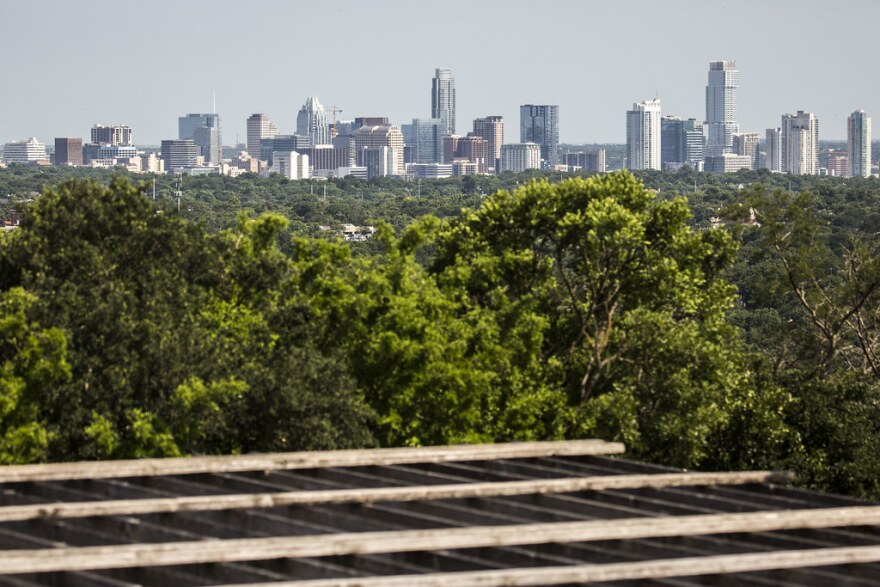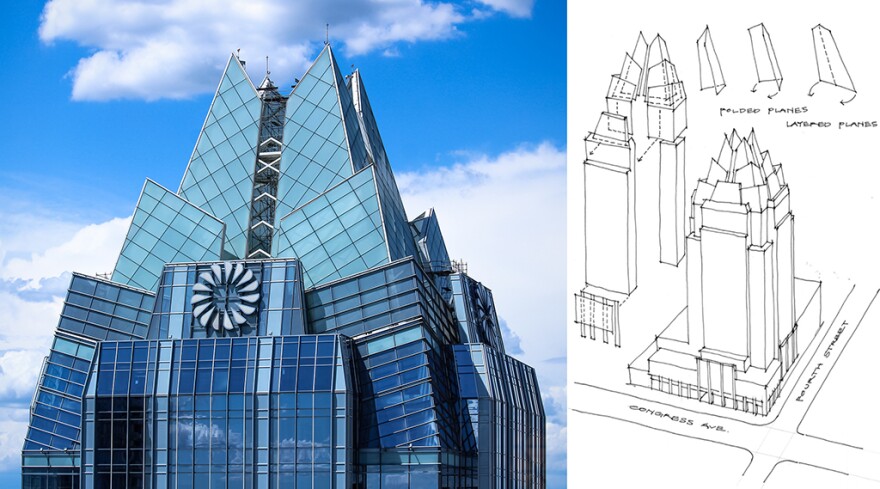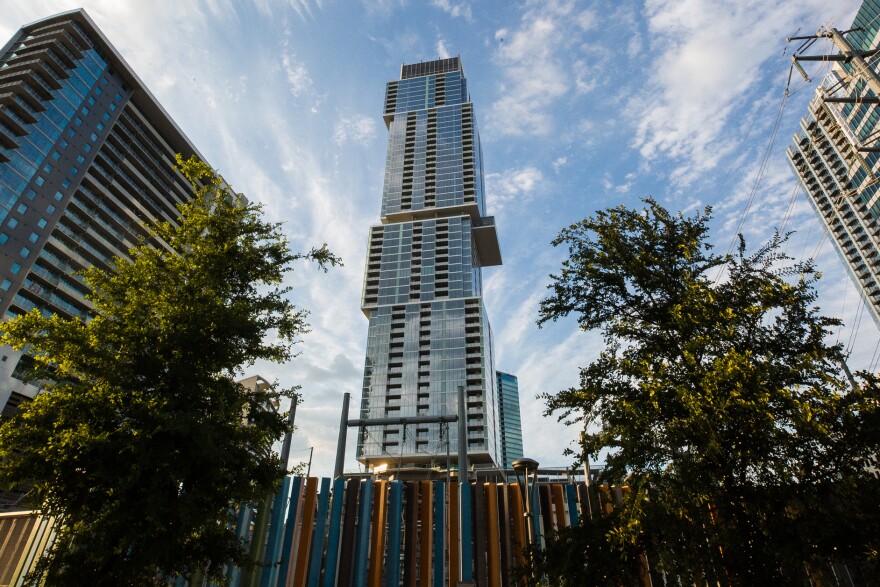This story was originally published on July 15, 2019.
The Independent, at 301 West Ave. in downtown Austin, is the city's newest tallest building. Some call it the "Jenga tower" because of its jagged appearance – shapes jutting out from the sides of the building.
The 59-story luxury apartment tower is definitely attention-getting, and some eyes are drawn all the way to the top – to what looks from afar like a tennis court or one of those nets to stop golf balls at a driving range.
ATXplained listener Jonathan Murphy wanted to know why it looks like that – and why people are so upset about it.
"People are very angry," Murphy says. "This is Austin – people are usually angry about something – but this building has definitely got people up in arms."
He says he doesn't know what's at the top or why it looks that way, but he says it looks "unfinished."
The outside is finished. It has been for months. But it’s the design of the top — or the “crown” — that has Jonathan curious.
"It's just such a strange choice that it's visible. I think whatever's up there, maybe we don't need to see – and so it's strange that they've left it so people can see it," he says. "There must be a reason behind it – I don't know what it is – but there must be a reason."
SUBSCRIBE | Find the ATXplained podcast on Apple Podcasts, Overcast, Pocket Casts or your favorite podcast player.
'Is That It?'
Now, there's no way to tell how many people are upset about the building or why. But we do know there's one guy who cared enough to start an online petition to have the "crown" of the Independent changed.

Ben Anstead lives on South Lamar, which means he sees the building every day – perfectly framed – on his drive to work downtown. He watched as workers put it up, floor by floor, but when they got to the top, he was like: "Is that it?"
"I thought – wait a minute," he says. "There's still more to do!"
The crown looks unfinished, he says. But why is he so offended by it?
"They went out of their way to build the tallest building in town by a couple of feet. They're the ones who kind of branded it as the crown," Anstead says. "They wrote media and press releases about rewriting the Austin skyline and then it just, you know, womp womp."
His online petition is tongue-in-cheek, he says, but he was surprised by how many people agreed with him. At last check, about 1,300 people have signed it.
Channeling Anxieties
Anstead's response says something about a city's skyline and the sense of ownership residents have over the most visible depiction of their city.
"We get to take pride in our skyline," he says. "Some people ask me, 'Why do you care about this?' And it's like – 'That's something we all look at literally every day.' You know, it's right in front of our faces. The skyline itself is something that belongs to the community."

Complaints about Austin's changes are not new. In fact, they've probably been happening since the city was founded.
"People who've been here for a long time feel a certain ownership of some elements of the city," says James Rambin, who runs the Austin Towers blog. He argues new development is unique in its ability to channel people's anxiety about larger issues – like affordability and traffic – into a physical form.
"It's a lot easier to blame ... big buildings than these abstract concepts," he says, like an outdated land development code, housing prices or the traffic caused by "antiquated" transit planning.
Rambin, who's a native Austinite, doesn't get worked up about the top of the Independent – or any other building. In fact, he likes the Independent.
"All this development – other than the issues regarding traffic and housing costs and all that – have made this city a more interesting, diverse, creative place," he says. "And so in a way, I think those towers to me represent the addition of creativity, the transformation of Austin into a world-class city."
'Outhouses' And 'Nose Hair Trimmers'
This is certainly not the first-time folks in Austin have gotten worked up about the top of a tall building here. The writer J. Frank Dobie reportedly said the top of the UT Tower looked like a "Greek outhouse." (One assumes that was not a compliment.) Back in 2004, when the Frost Bank tower on Congress Avenue was completed, there was some pushback over the ornamental glass peaks at the top.

"I've heard probably as many positive things as I have heard negative things," says Turan Duda of Duda Paine Architects in North Carolina, the firm that designed the Frost tower. At the time, it was the tallest building in Austin.
Those "negative things" were high profile. The late Statesman columnist John Kelso said the tower looked like a pair of nose hair trimmers. The Statesman's art critic Jeanne Claire van Ryzin wrote that the building looked like it could be in "Anycity, USA."
"If you think about any work of art, if it can have a reference of being more than one thing, I consider it a success," Duda says. "If you can label it as just being one thing, then it's just a one-liner."
(Incidentally, Duda did not go to Rice University and says he thinks the urban legend that the Frost tower was designed to look like the school's owl mascot is hilarious.)
Duda says he wasn't really bothered by the criticism, and he takes some satisfaction in how the city has embraced the design.
"You know that your building has been embraced when it starts showing up on postcards," Duda says. "I've noticed now that Frost Bank tower even shows up on your driver's license."

Other architects generally agreed that while some buildings get badmouthed at first, they're eventually accepted.
"I think that buildings, over time, they become a part of the city and a part of our culture and ... that kind of diminishes their individual impact on the city," says Sarah Johnson, an architect at MF Architecture in East Austin.
"You should have that thick skin when it comes to stuff like that," says Claudia de la Vega, an architect in West Lake Hills. "People are always going to have their opinions no matter how well-designed [a building] is or how gorgeous you think it's going to be. I mean, there's always going to be people that are going to not agree with you."
People may complain that the top of the Independent looks unfinished, she adds, but "that alone gives it its own unique characteristic."
So, Why Does It Look That Way?

We went to the top of the building with Brett Rhode from Rhode Partners, the architects for the Independent. He's already heard all this criticism.
"We had people that would come to me and say, ‘Will it stand up? It looks like it might fall over!'" Rhode says.
No, it's not going to fall over. But the reason the top looks the way it does does have something to do with the building's stability, he says. It's all about wind.
The top of the Independent has a couple of features. For one, it has these huge steel outriggers that stabilize it.

Two, at the very top of the huge concrete column is a giant water tank, called a "liquid tune damper." A building with this much surface area needs to withstand a lot of force from wind blowing against it, Rhode says. That force can cause the building to sway. Basically, the water in the damper tank sloshes around in response to the sway.

"That kind of slows down the movement," Rhode says. "And it works the best at the very top of the building."
Finally, there's mesh material that encases the whole top. Rhode says he wanted to make the top somewhat transparent, so you could see what's there. But the mesh also allows wind to pass through, reducing the force of the wind at the top of the building, where it would have the most impact.

In fact, if it weren't for these features, Rhode says, the top of the building might sway up to a foot and a half in each direction. Not exactly a comfortable feeling if you're living inside the building.
So that’s why it looks the way it does, but how does it feel to have this huge creation out in the open, for anyone to tell you exactly what they think about it? Does that kind of criticism feel bad?
"You stop and think, try to understand what their point of view is. So, in that sense, feel bad? No," Rhode says. "Maybe it's a little bit of a pause of reflection, if you will, to try to understand what that criticism is. And I've learned a lot from it. I don't know that we would have done anything different here, but I think it's something that does make you pause and think. And I think that's needed."
Rhode says one of his goals was to "up the ante," to "start a conversation" about the design of buildings along Austin's skyline. He knows there are haters, but in time, people may come to see the Independent as just as much a part of Austin as the Frost Bank tower.
"Even the Eiffel Tower was hated," Rhode says. "There was a huge move to tear it down."
He pauses.
"I'm not comparing our building to the Eiffel Tower, so I hope it doesn't come across that way."
In a sense, the top of the building isn't quite finished. Rhode says workers are adding lighting that can change colors, kind of like the top of the Empire State Building. Look for that later this year.
Update: Starting in February 2020, lights on the top of the Independent building turned on at night, lighting up the building. Additionally, the new Texas Driver Licenses no longer have the Chase building at the top.
_







